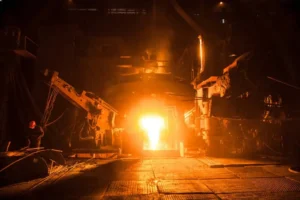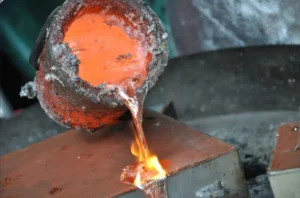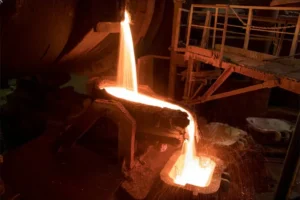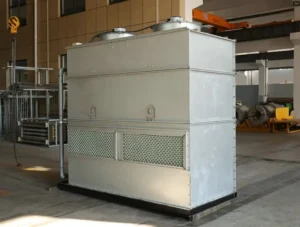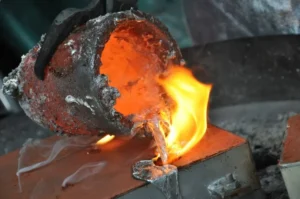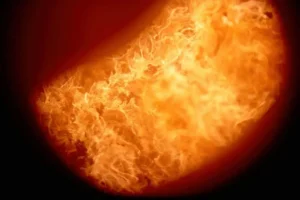কুলিং সিস্টেম ইন্ডাকশন চুল্লিগুলির জন্য গুরুত্বপূর্ণ, যেহেতু তারা অপারেশন চলাকালীন উল্লেখযোগ্য তাপ উত্পন্ন করে. যদি এই তাপটি কার্যকরভাবে এবং তাত্ক্ষণিকভাবে বিলুপ্ত না হয়, এটি অতিরিক্ত উত্তাপের দিকে নিয়ে যেতে পারে, যা ঘুরেফিরে কর্মক্ষমতা হ্রাস করতে পারে, সংক্ষিপ্ত জীবন, সরঞ্জাম ক্ষতি, বা এমনকি সুরক্ষার বিপত্তি কারণ.
কুলিং সিস্টেমের গুরুত্ব
ইন্ডাকশন ফার্নেস কুলিং সিস্টেমগুলি প্রাথমিকভাবে ব্যবহার করে জল শীতল বা এয়ার কুলিং, এবং কখনও কখনও উভয়ের সংমিশ্রণ.
- নিরাপদ সরঞ্জাম অপারেশন নিশ্চিত করা: উচ্চ তাপমাত্রা উভয় বৈদ্যুতিন এবং যান্ত্রিক সরঞ্জামের জন্য ক্ষতিকারক. ইন্ডাকশন চুল্লিগুলিতে মূল উপাদানগুলি, যেমন ইন্ডাকশন কয়েল এবং থাইরিস্টর, অপারেটিং করার সময় যথেষ্ট তাপ উত্পন্ন করুন. অতিরিক্ত তাপমাত্রা সরাসরি এই উপাদানগুলিকে ক্ষতি করতে পারে, সম্ভাব্যভাবে আগুন বা বিস্ফোরণে নেতৃত্ব দেয়. কুলিং সিস্টেমগুলি কার্যকরভাবে এই তাপটি সরিয়ে দেয়, নিরাপদ অপারেটিং তাপমাত্রার মধ্যে সরঞ্জাম রাখা.
- সরঞ্জাম জীবনকাল বাড়ানো: উচ্চ তাপমাত্রায় অবিচ্ছিন্ন অপারেশন উপাদান বয়স বাড়ানো ত্বরান্বিত করে, সরঞ্জাম জীবনকাল হ্রাস. একটি শক্তিশালী কুলিং সিস্টেম সরঞ্জামের তাপমাত্রা নিয়ন্ত্রণ করতে সহায়তা করে, উপাদান অবক্ষয়কে ধীর করে দেয় এবং এর ফলে ইন্ডাকশন চুল্লির সামগ্রিক জীবনকাল প্রসারিত হয়.
- উত্পাদন দক্ষতা উন্নতি: স্থিতিশীল অপারেটিং তাপমাত্রা আনয়ন চুল্লিগুলিকে দক্ষ উত্তাপের কার্যকারিতা বজায় রাখতে সহায়তা করে. যদি অপর্যাপ্ত শীতলকরণ ঘন ঘন অতিরিক্ত গরম শাটডাউন বাড়ে, এটি উত্পাদন দক্ষতার উপর মারাত্মকভাবে প্রভাবিত করতে পারে.
- শক্তি সংরক্ষণ: একটি কার্যকর কুলিং সিস্টেম তাপ হ্রাস হ্রাস করতে পারে এবং শক্তি ব্যবহারের উন্নতি করতে পারে. উদাহরণ স্বরূপ, কিছু ক্লোজড লুপ ওয়াটার কুলিং সিস্টেম শীতল জল পুনর্ব্যবহার করতে পারে, জল খরচ হ্রাস.
বিভিন্ন শীতল পদ্ধতি: ভূমিকা এবং রক্ষণাবেক্ষণ
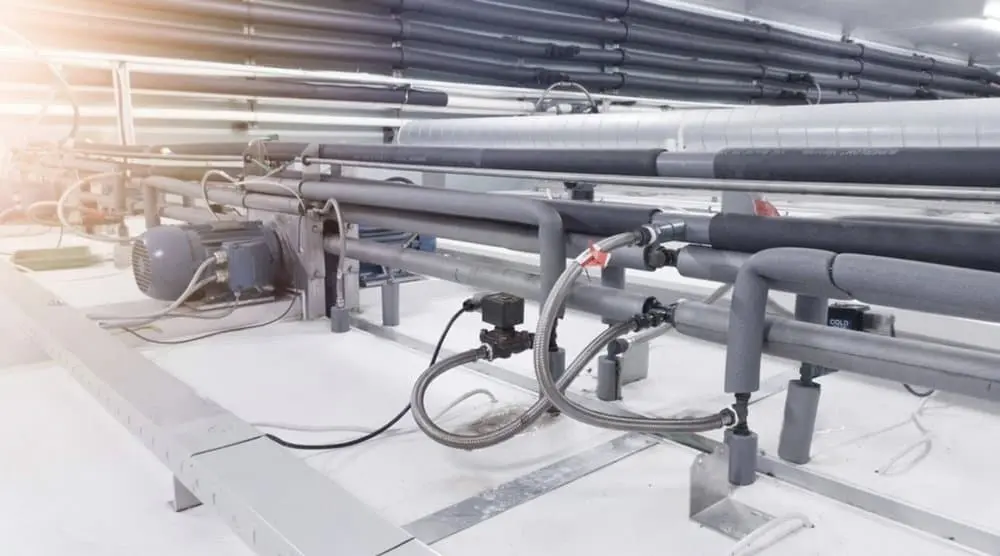
জল কুলিং সিস্টেম
জল শীতল ইন্ডাকশন চুল্লিগুলির জন্য সবচেয়ে সাধারণ শীতল পদ্ধতি, বিশেষত উচ্চ-শক্তি ইউনিটগুলির জন্য, এর অত্যন্ত দক্ষ তাপ অপচয় হ্রাসের কারণে.
ভূমিকা
জল কুলিং সিস্টেমগুলি সাধারণত ইন্ডাকশন কয়েলগুলির মতো গরম উপাদানগুলি থেকে তাপ অপসারণ করতে শীতল জল প্রচার করে, থাইরিস্টর, এবং ক্যাপাসিটার. নীতিটি পানির উচ্চ নির্দিষ্ট তাপ ক্ষমতা এবং ভাল তাপ পরিবাহিতা উপর নির্ভর করে. একটি পাম্প উত্তপ্ত উপাদানগুলিতে চ্যানেলগুলির মাধ্যমে শীতল জল সঞ্চালন করে. জল তাপ শোষণ করে, এর তাপমাত্রা বৃদ্ধি পায়, এবং তারপরে এটি শীতল টাওয়ারগুলির মতো সরঞ্জামের মাধ্যমে পরিবেশে এই তাপটি প্রকাশ করে, চিলার, বা তাপ এক্সচেঞ্জার. শীতল জলটি তখন পুনরায় পুনর্নির্মাণ করা হয়.
জল কুলিং সিস্টেমের সুবিধা
- উচ্চ তাপ অপচয় দক্ষতা: জল বাতাসের চেয়ে উত্তাপ অনেক ভাল পরিচালনা করে, এটি দ্রুত এবং কার্যকরভাবে প্রচুর পরিমাণে তাপ অপসারণ করতে দেয়, এটি উচ্চ-শক্তি সরঞ্জামের জন্য উপযুক্ত করে তোলা.
- সুনির্দিষ্ট তাপমাত্রা নিয়ন্ত্রণ: সুনির্দিষ্ট তাপমাত্রা নিয়ন্ত্রণ অর্জন করা সহজ, সরঞ্জামগুলি তার অনুকূল অপারেটিং তাপমাত্রার সীমার মধ্যে রাখা.
- তুলনামূলকভাবে ছোট পদচিহ্ন: সমতুল্য তাপ অপচয় হ্রাস ক্ষমতা সহ এয়ার কুলিং সিস্টেমের সাথে তুলনা, জল শীতল সরঞ্জাম সাধারণত আরও কমপ্যাক্ট হয়.
জল কুলিং সিস্টেমের অসুবিধাগুলি
- জল প্রয়োজন উত্স: জলের সংস্থানগুলির উপর নির্ভর করে এবং পাম্পগুলির মতো সহায়ক সরঞ্জামগুলির প্রয়োজন, পাইপ, কুলিং টাওয়ার, বা চিলার.
- সম্ভাব্য ফুটো ঝুঁকি: পাইপ, জয়েন্টগুলি, এবং অন্যান্য উপাদানগুলি ফাঁসের ঝুঁকি বহন করে, যা সরঞ্জামগুলি যদি তারা ঘটে তবে ক্ষতি করতে পারে.
- জলের মানের প্রয়োজনীয়তা: শীতল জলের গুণমান উল্লেখযোগ্যভাবে সিস্টেম অপারেশনকে প্রভাবিত করে. স্কেল বিল্ডআপ এবং জারাগুলির মতো ইস্যুগুলি ব্লকজেজ এবং হ্রাস তাপের অপচয় হ্রাসের দিকে নিয়ে যেতে পারে.
- শীতকালীন ফ্রিজ সুরক্ষা: ঠান্ডা অঞ্চলে, শীতকালে শীতল জলকে হিমায়িত এবং ক্ষতিকারক পাইপ এবং সরঞ্জাম থেকে রোধ করার জন্য অ্যান্টি-ফ্রিজের ব্যবস্থাগুলি প্রয়োজনীয়.
রক্ষণাবেক্ষণ জল কুলিং সিস্টেমের
- জলের গুণমান পরিচালনা: নিয়মিত শীতল জলের গুণমান পরীক্ষা করুন, পিএইচ সহ, কঠোরতা, এবং ক্লোরাইড সামগ্রী. স্কেলিং প্রতিরোধের জন্য প্রয়োজনীয় জল চিকিত্সা এজেন্ট যুক্ত করুন, জারা, এবং মাইক্রোবায়াল বৃদ্ধি. পরিশোধিত বা ডিওনাইজড জল ব্যবহার করার পরামর্শ দেওয়া হয়.
- নিয়মিত পরিষ্কার: পর্যায়ক্রমে কুলিং পাইপগুলি পরিষ্কার করুন, রেডিয়েটার, ফিল্টার, এবং স্কেল অপসারণ করতে শীতল টাওয়ার, ময়লা, এবং অমেধ্য, মসৃণ জলের প্রবাহ নিশ্চিত করা এবং তাপ অপচয় হ্রাস দক্ষতা উন্নত করা.
- ফাঁস পরিদর্শন: নিয়মিত সমস্ত জলের পাইপ পরিদর্শন করুন, জয়েন্টগুলি, ভালভ, এবং ফুটো জন্য পাম্প, তাত্ক্ষণিকভাবে কোনও সমস্যা চিহ্নিত করা এবং সম্বোধন করা.
- জমা সুরক্ষা ব্যবস্থা: শীতের আগে, স্থানীয় তাপমাত্রার উপর ভিত্তি করে প্রয়োজনীয় অ্যান্টি-ফ্রিজ ব্যবস্থাগুলি প্রয়োগ করুন, যেমন অ্যান্টিফ্রিজে যুক্ত করা, শীতল জল জল, বা প্রচলন পাম্পগুলি চলমান রাখা.
- পাম্প এবং ভালভ পরিদর্শন: নিয়মিত শীতল জল পাম্পগুলির অপারেটিং স্থিতি পরীক্ষা করুন, শব্দ সহ, কম্পন, এবং বর্তমান, যথাযথ কার্যকারিতা নিশ্চিত করা. ভালভগুলি নমনীয় এবং নির্ভরযোগ্য তা পরীক্ষা করে দেখুন.
- তাপমাত্রা এবং প্রবাহ পর্যবেক্ষণ: শীতল জলের খালি এবং আউটলেট তাপমাত্রা এবং প্রবাহের হারগুলি পর্যবেক্ষণ করুন যাতে তারা সাধারণ রেঞ্জের মধ্যে রয়েছে তা নিশ্চিত করার জন্য. মাঝারি ফ্রিকোয়েন্সি ফার্নেস কুলিং ওয়াটার সিস্টেমগুলির আউটলেট তাপমাত্রা এবং ইনলেট/আউটলেট প্রবাহের পার্থক্যের জন্য একটি অ্যালার্ম ডিভাইস থাকা উচিত, অপর্যাপ্ত শীতল হওয়ার কারণে সরঞ্জামের ক্ষতি রোধ করতে মাঝারি ফ্রিকোয়েন্সি পাওয়ার সাপ্লাইয়ের সাথে জড়িত.
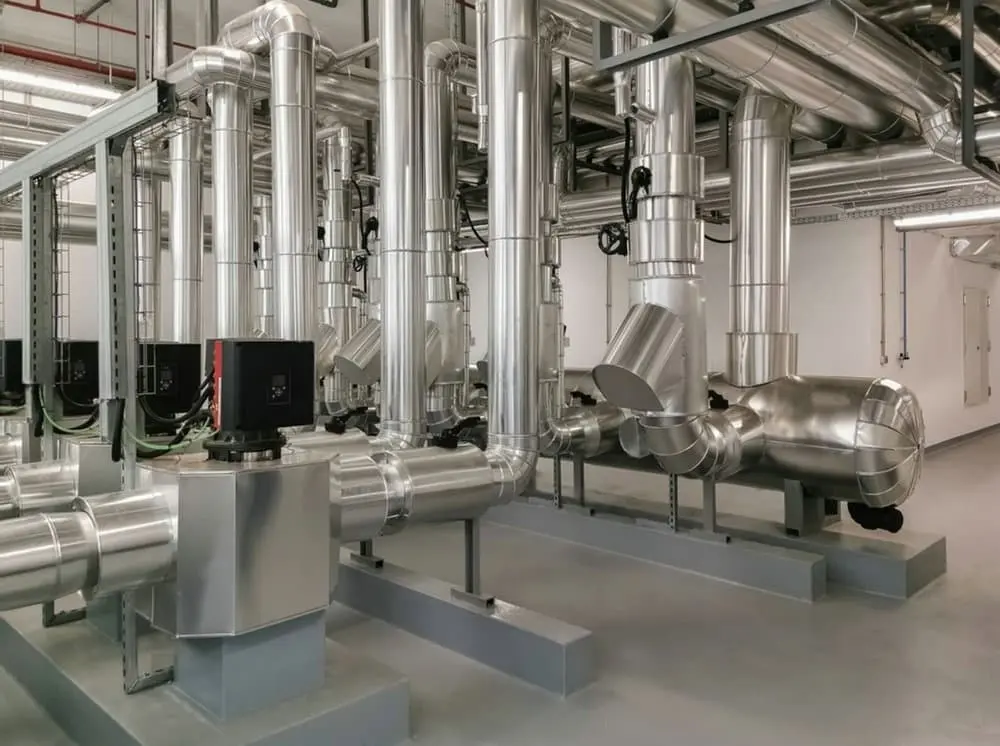
এয়ার কুলিং সিস্টেম
এয়ার কুলিং সিস্টেমগুলি তাপকে বিলুপ্ত করতে শীতল মাধ্যম হিসাবে বায়ু ব্যবহার করে. এই পদ্ধতিটি ছোট পাওয়ার ইন্ডাকশন চুল্লিগুলিতে বা কম কঠোর তাপ অপচয় হ্রাসের প্রয়োজনীয়তা সহ ব্যবহৃত হয়, বা জল শীতল সিস্টেমের সহায়ক হিসাবে.
ভূমিকা
এয়ার কুলিং সিস্টেমগুলি সাধারণত হট উপাদানগুলির তাপের ডুবে যাওয়া এয়ারফ্লোকে জোর করার জন্য ভক্তদের ব্যবহার করে, উত্তাপ দূরে বহন. বায়ু তাপ শোষণ করে, এর তাপমাত্রা বৃদ্ধি পায়, এবং তারপরে এটি সরাসরি পরিবেশে বহিষ্কার করা হয়.
সুবিধা এয়ার কুলিং সিস্টেম
- সাধারণ কাঠামো: সাধারণত কেবল ভক্ত এবং তাপ ডুবে প্রয়োজন, কাঠামোটি তুলনামূলকভাবে সহজ করে তোলা, ইনস্টল করা সহজ, এবং বজায় রাখা.
- কোনও ফুটো ঝুঁকি নেই: শীতল মাধ্যম হিসাবে জল ব্যবহার করে না, ফুটো সমস্যা দূর করা.
- তুলনামূলকভাবে কম ব্যয়: প্রাথমিক বিনিয়োগ এবং অপারেটিং ব্যয় সাধারণত জল কুলিং সিস্টেমের চেয়ে কম থাকে.
- পরিবেশ বান্ধব: জল দূষণ উত্পন্ন করে না এবং অতিরিক্ত জল খাওয়ার প্রয়োজন হয় না.
এর অসুবিধা এয়ার কুলিং সিস্টেম
- কম তাপ অপচয় হ্রাস দক্ষতা: বায়ুর তাপ পরিবাহিতা জলের চেয়ে নিকৃষ্ট, কম তাপ অপচয় হ্রাস দক্ষতার ফলে, এটি উচ্চ-শক্তি সরঞ্জামের জন্য অনুপযুক্ত করে তুলছে.
- পরিবেষ্টিত তাপমাত্রা দ্বারা অত্যন্ত আক্রান্ত: তাপ অপচয় হ্রাস কার্যকারিতা উল্লেখযোগ্যভাবে পরিবেষ্টিত তাপমাত্রা এবং বায়ু প্রবাহ দ্বারা প্রভাবিত হয়.
- শব্দ: ভক্তরা অপারেশন চলাকালীন শব্দ উত্পন্ন করে; উচ্চ-শক্তি ভক্তরা বেশ জোরে হতে পারে.
- ধুলা জমে: তাপ সিঙ্কগুলি সহজেই ধূলিকণা জমে থাকতে পারে, যা তাপ অপচয়কে প্রভাবিত করে এবং নিয়মিত পরিষ্কার করার প্রয়োজন হয়.
বায়ু কুলিং সিস্টেম রক্ষণাবেক্ষণ
- নিয়মিত পরিষ্কার: মসৃণ বায়ু প্রবাহ নিশ্চিত করতে এবং তাপের অপচয় হ্রাসের দক্ষতা উন্নত করতে পর্যায়ক্রমে তাপ সিঙ্ক এবং ফ্যান ব্লেড থেকে ধুলো এবং ধ্বংসাবশেষ পরিষ্কার করুন.
- ফ্যান অপারেশন চেক: নিয়মিত ভক্তদের অপারেটিং স্থিতি পরীক্ষা করুন, শব্দ সহ, কম্পন, এবং গতি, তারা সঠিকভাবে কাজ করছে তা নিশ্চিত করার জন্য. যদি কোনও অস্বাভাবিকতা পাওয়া যায় তবে তাদের তাত্ক্ষণিকভাবে ঠিকানা বা প্রতিস্থাপন করুন.
- বায়ুচলাচল পথ পরিদর্শন: নিশ্চিত করুন যে সরঞ্জামগুলির এয়ার ইনলেট এবং আউটলেটগুলি অবরুদ্ধ নয়, ভাল বায়ুচলাচল বজায় রাখা.
- পরিবেশগত নিয়ন্ত্রণ: সরঞ্জামগুলির অপারেটিং পরিবেশকে পরিষ্কার এবং ভাল বায়ুচলাচলে রাখার চেষ্টা করুন, উচ্চ তাপমাত্রা এবং উচ্চ আর্দ্রতা এড়ানো.
- তাপমাত্রা পর্যবেক্ষণ: তারা নকশার সীমাতে থাকা নিশ্চিত করার জন্য সমালোচনামূলক উপাদানগুলির তাপমাত্রা পর্যবেক্ষণ করুন.
উপসংহার
নির্বিশেষে জল শীতল বা এয়ার কুলিং ব্যবহৃত হয়, আনয়ন চুল্লিগুলির জন্য কুলিং সিস্টেমটি অত্যন্ত গুরুত্বপূর্ণ. কুলিং পদ্ধতির পছন্দ ইন্ডাকশন চুল্লির শক্তির মতো কারণগুলির উপর নির্ভর করে, প্রয়োগের দৃশ্য, পরিবেশগত পরিস্থিতি, এবং বাজেট. যাহোক, নির্বাচিত শীতল পদ্ধতি নির্বিশেষে, নিয়মিত রক্ষণাবেক্ষণ এবং পরিদর্শন এর দক্ষ এবং স্থিতিশীল অপারেশন নিশ্চিত করার জন্য গুরুত্বপূর্ণ. কুলিং সিস্টেম রক্ষণাবেক্ষণকে অবহেলা করা কেবল সরঞ্জামের জীবনকালকে সংক্ষিপ্ত করতে পারে না এবং মেরামতের ব্যয় বাড়িয়ে তুলতে পারে তবে সুরক্ষার ঝুঁকিও বাড়িয়ে তোলে, মারাত্মকভাবে প্রভাবিত উত্পাদন. অতএব, ব্যবসায়ের একটি বিস্তৃত কুলিং সিস্টেম রক্ষণাবেক্ষণ পরিকল্পনা প্রতিষ্ঠা করা এবং কঠোরভাবে অনুসরণ করা উচিত.


